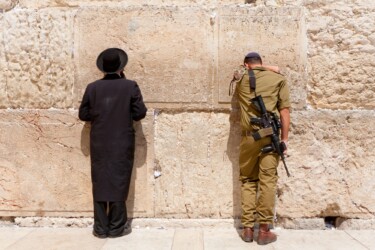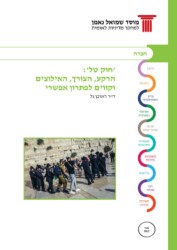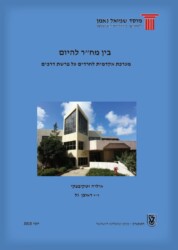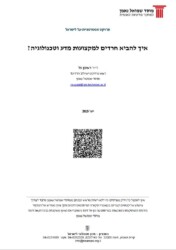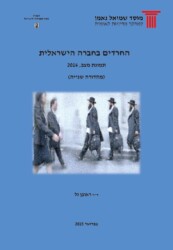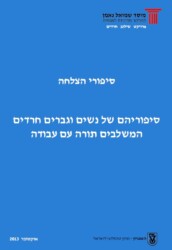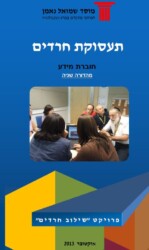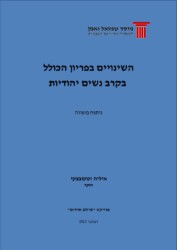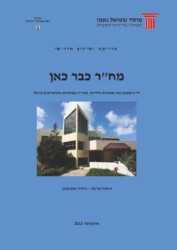A short documentary film (in Hebrew) depicting the activity of the “Integrating the Ultra-Orthodox Population in the Israeli Economy” project in recent years, and the contribution to the process of integrating Haredim in the Israeli economy:
The Ultra-orthodox (U-O) Integration Project was inaugurated at the Samuel Neaman Institute in 2010, following the recommendations of the ”Israel 2028” Project. The goals of the UOI Project were to investigate the subject and provide recommendations as to how to enhance the participation of the U-O population in the labor market in Israel. During the last 6 years, the project team has produced a multitude of analyses on various aspects of the subject matter and has published numerous reports, which in turn had significant impact on the national policy in this area.
In 2016: the project’s activities focused on the following areas: mentoring a forum of social activists from the U-O community, consultation, providing data, and delivering policy papers to various governmental bodies. In addition, during 2016, we completed a study on The potential for Excellence in Mathematics and Physics Studies within the Ultra-orthodox Educational System, solicited and funded by the Trump Foundation. An interim report was submitted to the Foundation toward the end of the year.
Further, following several research efforts conducted within our project on the integration of U-O students in academic institutions, we initiated various interventions (meetings, correspondences, consultations) related to the MACHAR Project (Haredi Settings) led by the PBC/CHE. In the near future, we will conduct a brain-storming meeting aimed at exploring feasible alternatives to the existing program in this field.
In 2014-15: the Project’s activities were reduced to the following areas:
Consultation, providing data and policy papers to governmental bodies: various Knesset committees, government offices, military officials and more.
Presenting the subject at non-governmental forums and in the media.
The following reports were published and disseminated.
- Ultra-Orthodox Jews in Israel: A Status Report, 2014 (2nd Edition).
- Between (MACHAR) Tomorrow and Today: Academic System for Haredim at a Cross-Road
- How to Bring Haredim to Science and Technology?
- The Haredim in the Israeli Society: Characteristics, Transitions and Predictions.
Moreover, during 2015 a survey was conducted among all relevant institutions in the country for the purpose of checking the success (or lack thereof) of the MACHAR Project (Haredi Settings) led by the PBC/CHE; activities were regularly conducted within the Haredi community in two main areas: a forum of social activists and contacts with rabbis and heads of the Orthodox community. Toward the end of the year, two research proposals were approved in principle, related to promoting academic excellence (for example, 5 study units for matriculation in mathematics and science) among the Ultra-Orthodox pupils. Work on the study will commence soon.
Field work: Much of the Project’s activities [conducted by its head (R.G.)] was devoted this year to direct interactions with inner ‘agents’ within the U-O community, primarily:
The ‘Social Activists’ Forum.
Contacts with senior Rabbis.
Collaborations: Throughout 2014, the head of the project was involved directly with several other projects conducted at SNI: “Northern Project” – Mr. Yehuda Morgenstern is the research assistant in this effort; Grand-Strategy Project; and Round-table on the subject of ‘IDF’s Service Model,’ organized by the head of the project (R.G.), together with Prof. Shlomo Maital.
In 2013, the project recorded impressive achievements due to its ongoing activity.
* Military and Civic Service – Formulation of new legislation aimed at replacing the “Tal Law” (which was canceled by the Supreme Court). At all stages of the legislative work, the study data and position papers, formulated and written by the project team, were used by the members of the various committees, and the project leader actively participated in deliberations held in the various committees and served as a professional consultant on issues.
* Education – a number of research reports were published, on the one hand indicating the potential of the Ultra-Orthodox students in Israel, and on the other hand monitoring and reporting on the achievements of the Mahar project (on behalf of the PBC/CHE) so far. In addition, the Ministry of Education adopted the “English, Mathematics & Computers Report” (published by us in March 2012) and budgeted the first pilot program, based on the report’s recommendations. The project team also continues to accompany the new preparatory courses launched at the Technion and other institutions for Haredi students.
* qEmployment – Two major publications appeared, ‘An information booklet for employers’ and the book ‘Success stories,’ which have aroused great interest and were widely distributed. The Shachmat Project (integrating the Ultra-Orthodox in technological plants) continued its activities in promoting the integration of the Ultra-Orthodox in high-tech industries. 2013 also saw the beginning of a new channel of activity related to the project: intervention in internal circles among the Ultra-Orthodox community to encourage and foster ‘social activists’ within the Ultra-Orthodox community and build ‘bridges’ with the spiritual leadership of this community.
The Project’s work is conducted in coordination with relevant government agencies, including the Prime Minister’s Office (and the National Economic Council), the Ministry of Industry, Trade and Labor, Finance Ministry, Education Ministry and the IDF. The dissemination of the project’s annual report to all Knesset members and government ministers allowed the project to get a foothold at the decision making and the legislature levels.
Activity:
- Participation in Caesarea Conference – examining the required policy with regards to young orthodox men, and recent government changes in policy.
- Organizing and producing a multidisciplinary Seminar on the subject, with many participants, June 2011 – Jerusalem.
- Establishing a ‘Researchers Forum’, with the aim of furthering the research activity being conducted in Israel on subjects related to the Ultra-Orthodox community.
- Establishing a ‘Heads-of-College Forum’, to promote, encourage and strengthen institutes offering academic training for the ultra-orthodox.
- Facilitating the collaboration of the ORT College network with ‘Migdal Or’ educational institutes headed by Rabbi Grossman.
- Paper entitled ‘Immigration Model’, a national-strategic plan, describing the challenge of integrating the Ultra-Orthodox, drawing strategic parallels with the integration of immigrants in Israel. The significance of this mode of thinking is to leave no alternative for the state but to integrate the Haredim into the workforce. (See attached).
- A Working Paper regarding ‘Young Haredim: an assessment for 2011 and three possible scenarios for 2021
- Success Stories – collecting 100 success stories from within the Haredim world, with the help of Moshe Berman and Haya Feder, emphasizing the less known achievements and raising them to public awareness and to the awareness of decision makers.
- The work of Mayan Shachaf and Yehuda Morgenstern regarding AMA”M – a detailed study regarding the possibility of incorporating the study of the three core subjects English-Math-Computers into the Haredim educational system.
- Participation in Shderot Conference – conducting a panel on the subject of Haredim Integration including a central lecture by Dr Reuven Gal.
- Collating Information for the Employer, including an ‘Employer Information Booklet’. The work of Hudi Zak, aimed at streamlining the uptake of Haredim employees by potential employers.
- Dr Reuven Gal appearance in the Trachtenberg Committee, a committee set up to examine the social injustice agenda, brought to the fore by repeated mass protests of the Israeli public. Much of its recommendations stem directly from the project’s Roadmap Report and Gal’s appearance.
- Periodical Distribution of a Newsletter and Selected Articles, to an ever growing list of interested parties from employment, education, entrepreneurship, and others.
2012 saw extensive activity of the Project in the following areas:
- Military Service: Members of the Project were commissioned as an advisory body to several Knesset committees — the Knesset Foreign Affairs Committee, and the Plesner Committee. A special workshop was given to the IDF Personnel Directorate staff on the subject of the Haredi society and alternatives to the Tal Law.
- Education: Activities include mapping the Haredi educational institutions, publishing the “EMC — English, Mathematics, and Computers — Report, and advising to the Technion and other academic institutions on the issue of integrating U-O students in higher education.
- Employment: The Shachmat Program (Ultra-Orthodox Integration in Technological Enterprises) was designed, to promote the integration of the Ultra-Orthodox in high-tech industries.
During 2011 we have witnessed far reaching changes in the integration of the Ultra-Orthodox population into Israeli economy. While not exclusively responsible for all these changes, the results of the accelerated activity by the project team began to make its impact. There are reports of a marked rise in the number of Haredim students (a total of 6500 students), of success stores in the employment arena, and of a growing participation in the various IDF Shach”ar frameworks.
The Haredim Integration Project has gradually become one of the leading bodies carrying out the change. Thanks to a grant received from the Jewish Federation in New York (UJAFedNY), the team have been able to turn their attention to other areas of activity, namely Information and Public Relations.
Below is a list of publications published in the project and videos(in Hebrew):
Newsletters
A strategic plan to integrate the ultra-Orthodox population into Israeli economy
Writers of “success stories”: M. Berman and H. Feder.
Researchers of “Integrating English, Mathematics, Computers in the Ultra-Orthodox Education System,” M. Shahaf and Y. Morgenstern



